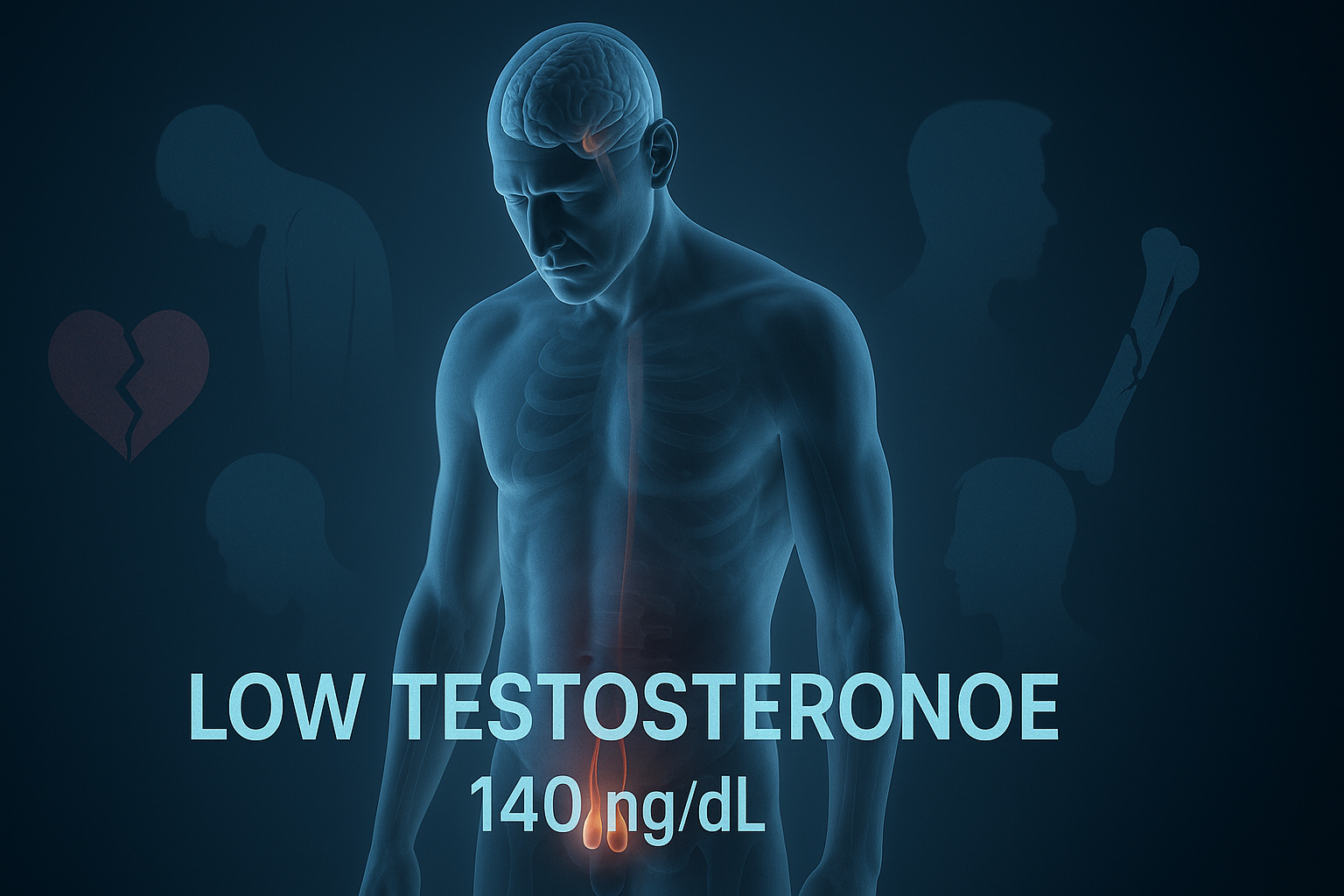Testosterone Level 140 : Is It Dangerous, Causes, Symptoms, Treatment
A testosterone level of 140 ng/dL is considered to be very low and indicates that the testicles are not producing enough testosterone. This condition is known as hypogonadism. Low testosterone can cause a range of symptoms such as fatigue, low sexual drive, loss of muscle mass, and increased risk of heart and bone problems. In this article, we explain what a testosterone level of 140 means, how dangerous it can be, what symptoms to look for, possible causes, and treatment options.

What Does a Testosterone Level of 140 Mean?
A testosterone level of 140 ng/dL is well below the normal range for adult males. Normal total testosterone levels typically range from 300 to 1000 ng/dL. Here’s what this means for your health:
- Low Testosterone Production: Your testicles are not producing enough testosterone, which is essential for male sexual function, bone strength, and overall energy.
- Very Low Value: Any value below 230 ng/dL is considered very low and usually requires medical evaluation.
- Symptoms Required: Diagnosis of testosterone deficiency requires both a low test value and physical or emotional symptoms.
- Repeat Testing: The test should be repeated in the morning (8–10 a.m.) to confirm the result, since testosterone levels vary throughout the day.
- Doctor’s Role: If confirmed, your doctor may recommend treatment to restore normal hormone levels.
How Dangerous is Low Testosterone?
Persistently low testosterone levels can be dangerous to long-term health. Several studies have shown that very low testosterone increases the risk of heart disease, stroke, fractures, and even early death. The degree of risk rises sharply below certain thresholds.
| Testosterone Level (ng/dL) | Associated Risk |
|---|---|
| 153 | Increased risk of heart attack or stroke |
| <213 | Higher overall mortality risk (death from any cause) |
| <300 | Markedly increased risk of changes to quality of life, and appearance of symptoms, including weakness of bones amongst other changes |
In summary, a testosterone level of 140 ng/dL is not just low—it is medically significant and should be investigated and treated promptly to avoid serious health complications.
Symptoms of Low Testosterone
Low testosterone can affect both physical and mental health. Symptoms vary between men, but most patients with a level of 140 ng/dL experience several of the following:
- Sexual Symptoms: Reduced sexual desire, fewer or absent early morning erections, and erectile difficulties.
- Hair and Body Changes: Loss of hair in the armpits and pubic region, and reduced beard growth.
- Reproductive Issues: Very low sperm counts, infertility, or difficulty conceiving.
- Energy and Mood: Persistent tiredness, laziness, irritability, and low motivation.
- Other Signs: Hot flashes, loss of smell, or in rare cases, sudden vision changes due to pituitary problems.
If you notice these symptoms along with a low testosterone report, you should discuss them with your doctor before beginning any treatment.
Causes of Low Testosterone (140 ng/dL)
There are multiple causes for low testosterone levels. These can be divided into problems with the testicles (primary hypogonadism) and problems with the brain or pituitary gland (secondary hypogonadism).
1. Testicular Causes
- Injury, infection (mumps orchitis), or surgical removal of the testicles.
- Damage from chemotherapy or radiation therapy.
- Genetic conditions such as Klinefelter Syndrome (47,XXY) or Prader-Willi Syndrome.
2. Brain and Pituitary Causes
- Pituitary tumors, radiation exposure, infections, or head injuries.
- Genetic syndromes like Kallmann Syndrome or 46,XY disorders that affect hormone signaling.
3. Lifestyle and Medical Conditions
- Obesity, diabetes, high blood pressure, and high cholesterol can all suppress testosterone production.
- Chronic illness, stress, or certain medications—especially anabolic steroids and prostate cancer drugs—can also lower testosterone.
Other Tests to Consider
To confirm and understand the cause of low testosterone, doctors usually order additional tests:
- LH (Luteinizing Hormone) Test: Helps determine whether the problem lies in the testicles or the brain.
- Prolactin Test: Elevated levels can indicate a pituitary tumor (prolactinoma).
- Sperm Count: Assesses fertility status.
- Free Testosterone and SHBG: Measures the active portion of testosterone in the blood.
- Brain MRI Scan: Recommended if pituitary or hypothalamic disease is suspected.
- Infection Tests: To rule out sexually transmitted or systemic infections affecting testicular function.
Treatment Options for Testosterone Level 140
The mainstay of treatment for low testosterone is Testosterone Replacement Therapy (TRT). The goal is to restore testosterone levels to the normal range and relieve symptoms.
1. Testosterone Replacement Therapy (TRT)
- Available as injections, skin gels, patches, or oral tablets.
- Your doctor will determine the most suitable form and dose based on your needs.
- TRT improves energy, mood, libido, and bone density, but should be monitored for side effects such as increased red blood cells or prostate enlargement.
2. Treating the Underlying Cause
- If due to pituitary disease, medications or surgery may be required.
- Address metabolic factors such as obesity, diabetes, and cholesterol through lifestyle modifications.
- Discontinue any medications that could be suppressing testosterone, under medical supervision.
3. Lifestyle Optimization
- Maintain a healthy weight through regular exercise.
- Eat a balanced diet with adequate zinc, vitamin D, and protein.
- Sleep 7–8 hours per night and manage stress effectively.
Always consult a qualified endocrinologist or urologist before starting testosterone treatment. Self-medication or using bodybuilding testosterone products can be dangerous.
Next Steps
A testosterone level of 140 ng/dL indicates severe testosterone deficiency. Get a repeat testosterone test done to confirm the level. If you are Pune, you can book a Testosterone blood test with Pathofast Lab.

 By: Dr.Bhargav Raut
By: Dr.Bhargav Raut